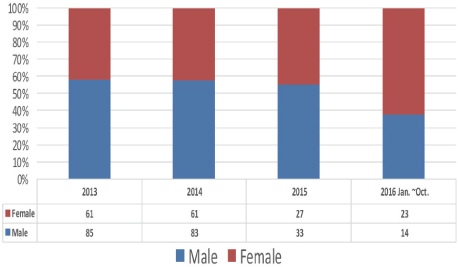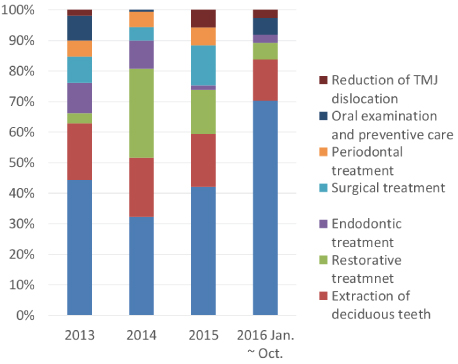J Dent Anesth Pain Med.
2016 Dec;16(4):283-288. 10.17245/jdapm.2016.16.4.283.
Survey of the sevoflurane sedation status in one provincial dental clinic center for the disabled
- Affiliations
-
- 1Department of Pediatric Department, School of Dentistry, Dankook University, Cheonan, Korea. ksomd@naver.com
- 2Department of Anesthesiology, School of Dentistry, Dankook University, Cheonan, Korea.
- KMID: 2366156
- DOI: http://doi.org/10.17245/jdapm.2016.16.4.283
Abstract
- BACKGROUND
Sevoflurane sedation in pediatric and disabled patients has the advantage of faster induction and recovery compared to general anesthesia, as well as minimum influence on the respiratory and cardiovascular functions, and airway protective reflexes. This study aimed to evaluate the clinical efficacy of sevoflurane sedation used in dental treatment at one provincial dental clinic center for the disabled.
METHODS
We investigated patients' gender, age, reasons for undergoing sedation, medication history prior to treatment, duration of anesthesia, treatment length, type of treatment, and yearly patterns, for 387 cases of dental treatment performed using sevoflurane sedation from January 2013 to October 2016.
RESULTS
We analyzed 387 cases (215 male patients, 172 female patients). Male patients aged 20 year or older accounted for 39.0% of all patients, marking the highest proportion. Patient's lack of cooperation was the most common reason for performing dental sedation. Prosthetic treatment was the most frequently practiced, accounting for 174 treatment cases. The mean lengths of the entire treatment and of the dental procedure were 55.2 min and 39.8 min, respectively.
CONCLUSIONS
Sevoflurane sedation has the advantage of fast anesthesia induction and recovery compared to general anesthesia; therefore, it can be used efficiently to induce anesthesia in pediatric and disabled patients during short dental procedures, enabling stable treatment of these patients.
Keyword
Figure
Cited by 1 articles
-
Difficult intubation caused by an immature upper airway in a patient with cri-du-chat syndrome: a case report
Eunsun So, Seungoh Kim
J Dent Anesth Pain Med. 2020;20(1):49-53. doi: 10.17245/jdapm.2020.20.1.49.
Reference
-
1. Jones RM. Desflurane and sevoflurane: inhalation anaesthetics for this decade? Br J Anaesth. 1990; 65:527–536.2. TerRiet MF, DeSouza GJA, Jacobs JS, Young D, Lewis MC, Herrington C, et al. Which is most pungent: isoflurane, sevoflurane or desflurane? Br J Anaesth. 2000; 85:305–307.3. Kanaya N, Hirata N, Kurosawa S, Nakayama M, Namiki A. Differential effects of propofol and sevoflurane on heart rate variability. Anesthesiology. 2003; 98:34–40.
Article4. Röhm KD, Wolf MW, Schöllhorn T, Schellhaass A, Boldt J, Piper SN. Short-term sevoflurane sedation using the Anaesthetic Conserving Device after cardiothoracic surgery. Intensive Care Med. 2008; 34:1683–1689.
Article5. Kim SO. A survey of general anesthesia, sevoflurane sedation and intravenous sedation in chungnam dental clinic for the disabled. J Korean Acad Pediatr Dent. 2013; 40:28–39.
Article6. Korea Employment Promotion Agency for the Disabled Employment Development Institute. 2015 Disability Statistics. Korea Employment Promotion Agency for the Disabled Employment Development Institute;2015. [2015 Dec 16].
Article7. Lee JH, Shon HK, Kim JH. A study on the treatment of dentally handicapped patients under outpatient general anesthesia. J Korean Acad Pediatr Dent. 1997; 24:581–589.
Article8. Seo KS, Shin TJ, Kim HJ, Han HJ, Han JH, Kim HJ, et al. Clinico-statistical analysis of cooperation and anesthetic induction method of dental patients with special needs. J Korean Dent Soc Anesthesiol. 2009; 9:9–16.
Article9. Kim SO, Kim YJ, Hyun HK, Koo YS, Shin TJ. Deep sedation with sevoflurane inhalation via a nasal hood for brief dental procedures in pediatric patients. Pediatr Emerg Care. 2013; 29:926–928.
Article10. Kim SO, Kim YJ, Koo YS, Shin TJ. Deep sedation with sevoflurane insufflated via a nasal cannula in uncooperative child undergoing the repair of dental injury. Am J Emerg Med. 2013; 31:894e1–e3.
Article11. Hosey MT. UK National Clinical Guidelines in Pediatric Dentistry. Managing anxious children: the use of conscious sedation in paediatric dentistry. Int J Paediatr Dent. 2002; 12:359–372.12. American Academy of Pediatric Dentistry. Clinical Affairs Committee – Sedation and General Anesthesia Subcommittee. Guideline on use of anesthesia personnel in the administration of office-based deep sedation/general anesthesia to the pediatric dental patient. Pediatr Dent. 2012; 34:170–172.
- Full Text Links
- Actions
-
Cited
- CITED
-
- Close
- Share
- Similar articles
-
- Application of sevoflurane inhalation sedation in dental treatment: a mini review
- Use of Sevoflurane Inhalation Sedation for Disabled Outpatient Dental Treatment
- A survey of the intravenous sedation status in one provincial dental clinic center for the disabled in Korea
- A Survey of the Outpatient General Anesthesia and Dental Treatment in Chungnam Dental Clinic for the Disabled
- A Survey of the Sedation or Outpatient General Anesthesia in Department of Pediatric Dentistry, Chonnam National University Dental Hospital and Gwangju Dental Clinic for the Disabled





